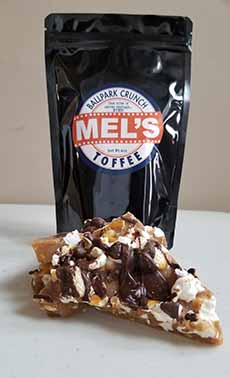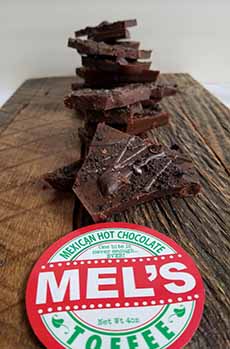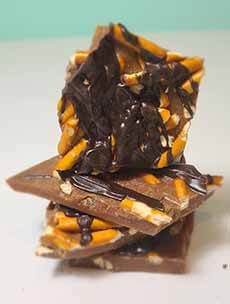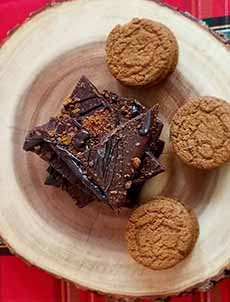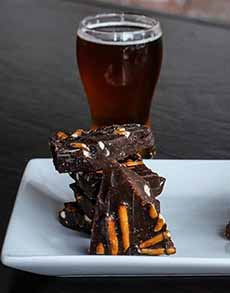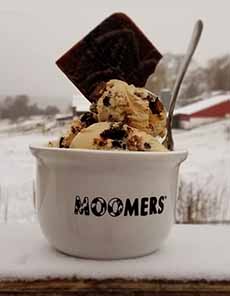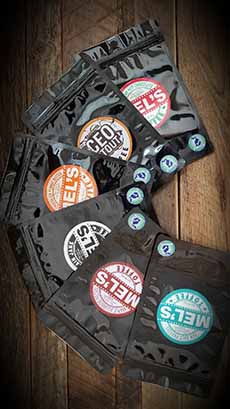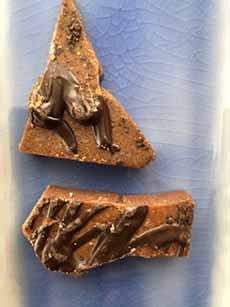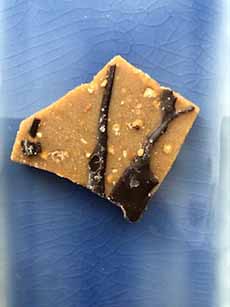Enjoy Mel’s Toffee In Many Delicious Flavors For All!
|
|
Our Top Pick this week is a delightful line of flavored toffee from Mel’s Toffee, an award winning Michigan Made Toffee company. The artisan, small batch toffee is made in Metro Detroit, and has become so popular with other Michigan artisans that it’s been used in artisan ice cream. More unusual—and delightful—local breweries have held toffee and beer tastings with their craft beers. We love toffee, and couldn’t wait to taste the flavors. We even held our own beer and toffee tasting. The pairings are below. And, the history of toffee, and the differences between English toffee, American toffee, buttercrunch, butterscotch and caramel are below. The best toffee—the best anything—starts with the best ingredients: butter, sugar, chocolate, cocoa powder, almonds, pecans, peanuts, craft beer. The ingredients speak for themselves. If you think “peanuts are peanuts,” for example: There’s a big difference between peanuts from small producers and peanuts from mass growers…well, think of an apple pie from a fine bakery versus one from the supermarket. Toffee comes under the “what’s not to like?” category, unless your teeth don’t like the hard toffee sticking in your teeth and threatening your fillings. Mel’s Toffee works around that issue, using beet sugar instead of cane sugar as the sweetener. When you crunch into it, it yields to your teeth and the “stick-to-them” factor is minimal. Mel’s makes “toffee with a twist.” The twist is the variety of delicious flavors, that gives each flavor a distinct personality. Mel’s decided to drizzle chocolate on top of the toffee, rather than enrobe each piece in chocolate. The approach makes the different flavors in the toffee stand out. We’ve included our beer pairings along with the flavors: Quarter-pound bags are $7.25. In addition to treating yourself, think of them as stocking stuffers and party favors. Michelle Williamson, who had previously worked in fine dining restaurants, was a stay-at-home mom in the greater Detroit area. When her two daughters went off to preschool, she began exploring what kind of food business she could create. After experimenting with chocolates, truffles, barks, turtles, chocolate-covered pretzels and specialty cookies, she decided to focus on toffee, and Mel’s Toffee was launched. The company name is a combination of her first initial and those of her daughters. Her husband’s initial didn’t fit in, so he is known as “the silent partner.” Most food historians agree that toffee is a creation of Great Britain, in the early 1800s. In dairying countries like England, butter was plentiful and sugar had become affordable. The result: toffee making (along with fudge, caramels, and other candies). The Oxford English Dictionary first mentions the word “toffee” in 1825. Since words were in use for some time before they were acknowledged in a dictionary, that’s what points to the early 1800s, for the appearance of toffee. The origins of the word toffee are not certain. Some believe it to be a form of the word “tafia,” a West Indies rum distilled from molasses. Possibly, the toffee, which is still made with molasses by some producers in the England, could have been made from the molasses syrup skimmed off the liquor during distillation. Toffee is made with caramelized sugar and butter. But follow the trail after that, and the descriptions get confusing, as you’ll see in the next section, “The Difference.” Brits favor a toffee recipe with brown sugar or molasses, which creates a darker flavor. Americans tend to use white sugar, which brings out the buttery qualities (although some American candy makers add some brown sugar to their mixes). Some sources tell you that American toffee is a hard substance, synonymous with brittle; while English toffee is more the consistency of what we call taffy. No: English toffee is as hard as it gets. Often, brittle and toffee are equally hard. Other sources say that English toffee is hard, and American toffee is somewhat softer. In some cases, depending on the producer. What is called English-style toffee in the U.S. is the hard sheet of toffee that the candy-maker breaks into pieces with a hammer. American-style toffee, when covered with crushed almonds, is called buttercrunch, and it can be coated with chocolate first*. Yet, many producers of buttercrunch call their products “toffee” or “almond toffee”—or worse, English toffee. Who wouldn’t be confused? Here’s the scoop> Classic English toffee is unadorned. If it’s covered with chocolate, it’s American style toffee; if crushed nuts are added, it’s buttercrunch. More than a few caramel apples are called “toffee apples.” Feel free to point out to the seller that if, in fact, there were toffee on the apples, you wouldn’t be able to bite into them. These candies are related, but differ in hardness and other features. Caramels are the softest of this group of candies, butterscotch is harder and toffee is the hardest. This is based on both ingredients and at how high a temperature the ingredients are boiled. Here’s a comparison: *The first well-known brand was Almond Roca, launched in 1923 by Brown & Hale of Tacoma, Washington. Roca means “rock” in Spanish. In those days, most almonds came from Spain, and the name suited the crunchy (“rock-like”)center. The name may have been coined by William Loft, who began a confectionery in 1860 and sold almond-coated toffee (alas, the business closed in the 1990s). †Some American producers may in fact make English-style toffee; but most of what we’ve seen called English toffee, isn’t. ‡The full name of this popular newsstand candy bar is Heath Milk Chocolate English Toffee Bar. It’s made of toffee, almonds and milk chocolate. It was first made by the Heath brothers in Robison, Illinois in 1928 (the brand is now owned by the Hershey Corporation). |
|
|
|
||
